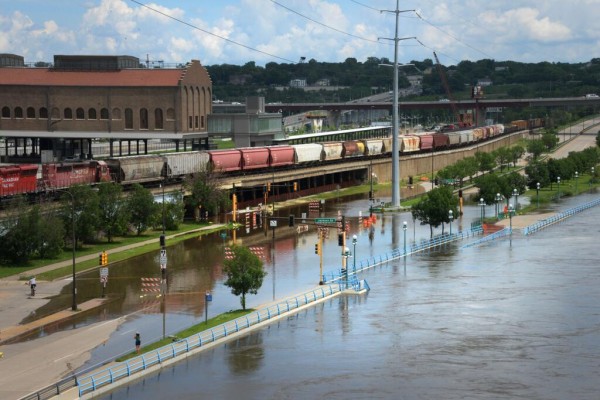
© Metropolitan CouncilSt Paul flooding.
Residents of several Midwest states would be just fine not seeing any more rainfall for a couple of weeks, but they might have to wait a few more days to get the fair weather they've craved.
River levels have soared over the past few weeks in South Dakota, Nebraska, Minnesota, Iowa and Wisconsin, flooding towns, killing crops and even
setting off a mudslide in Minneapolis. The Mississippi River has been pushed into major flood stage in the Twin Cities,
as have 50-year-old levees, according to TwinCities.com.
St. Paul, Minnesota, was placed under a state of emergency
for the first time since 2011, according to a Chicago Tribune report. The declaration allows the state to move necessary resources into the area to aid in the recovery.
"More clusters of thunderstorms with locally heavy rainfall are in the forecast throughout the weekend, possibly persisting through Monday in parts of the waterlogged Midwest," said weather.com senior meteorologist
Jon Erdman.
Though meteorologists can't forecast exactly where those storms will pop up, if they form over the hardest-hit areas, another several inches of rainfall could quickly overwhelm smaller streams and creeks, and trigger additional rises on mainstem rivers.
'This ... is the whole state'Other severe weather events - past floods included - have done little to prepare Minnesotans for the disaster unfolding all over the state. According to a New York Times report, this event
is happening later than most floods that affect Minnesota, which forced officials to quickly prepare emergency deluge-fighting procedures. Sandbags had to be collected by the thousands, while flood walls and barriers needed to be built to minimize the damage.
Still, this event was so vast that it was hard to protect everyone, everywhere.
"I've seen severe weather - tornadoes, flash floods and ice storms - but usually they impact one area of the state," Minnesota Gov. Mark Dayton told the Times. "This one is the whole state."
In St. Paul, the Mississippi River was expected to crest Thursday. The river is expected to remain at major flood stage through at least the middle of next week, depending on how much more rain the region receives.
Gov. Dayton visited flooded areas of the state including Delano, a community about 30 miles west of Minneapolis, where downtown businesses and a main bridge were swamped. President Barack Obama said during a visit to the state Thursday that
he will send federal aid to assist the flooded towns, the Star Tribune reported.
"For a community our size, we're expending a tremendous amount of resources," Delano city administrator Phil Kern
told NPR. "Probably upwards of 10 percent of our annual budget just simply in the last five days trying to deal with holding back these waters."
In Iowa, the National Weather Service reported river level readings in
flood stage over much of the state. Iowa's top emergency management official told the Associated Press that the state has suffered at least $15 million in damage from the flooding, and at least 150 homes have been severely damaged by high water, mostly in the northwestern parts of the state.
"This is now the record wettest month all-time in Sioux City, Iowa, topping the previous record wettest month set in May 1903 of 11.78 inches," said Erdman.
Wisconsin's crops have also been decimated by the flooding. A Milwaukee Journal Sentinel article cites a U.S. Department of Agriculture report that says
21 percent of Wisconsin's corn crop is in poor or fair condition, and the floods are to blame.
"Soil erosion, ponding and flooding were reported statewide, stressing or outright drowning some fields," the report said.
With the exception of areas near the Mississippi River, most of the Wisconsin's waterways
have dropped below flood stage, but, like its neighboring states to the west, the rains could return soon to disastrous effect.
'Mother Nature always wins'About those levees in Minnesota - once they go, they're gone for good, at least in the town of Newport. Built by the Army Corps of Engineers in 1969, the levee that protects Newport from the Mississippi River
could break if rainfall pushes the river level any higher, reports TwinCities.com.
Because the levee was built on private land, it hasn't been upgraded in more than 50 years, and the report mentions it would cost $10 million to repair a break, if it happens. A levee failure would leave at least eight homes in immediate danger of being destroyed by the floodwaters, TwinCities.com added.
City administrator Deb Hill knows the situation is becoming dire for the town, but their hands are tied. "It would not be cost-effective for that property," she told TwinCities.com, in regards to fixing the levee. "Mother Nature always wins."
Reader Comments
to our Newsletter